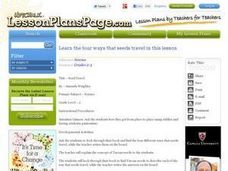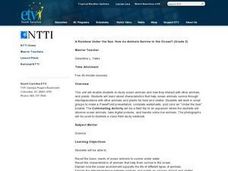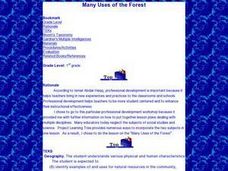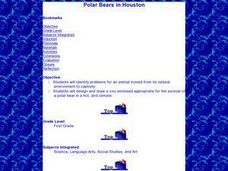Curated OER
What Do Monarch Caterpillars Eat?
Students use the scientific method to discover what monarch caterpillars eat. They observe the caterpillars for 2 minutes at a time and make observations.
Curated OER
Croc or Gator?
Students study the similarities and differences between crocodiles and alligators using online information. They develop a Venn diagram based on their research.
Curated OER
Marine & Aquatic Habitats Activities - Habitats of Birds, Fish, and Mammals on the Island and the Pacific Region
Learners create habitats in jars to understand integral aspects of plants' and animals' habitats.
Curated OER
Bean There, Done Plant
Students explain that events in nature follow an orderly progression when they plant seeds and observe the development of the seeds. They count seeds and find the likenesses and the differences of many seeds.
Curated OER
Spiders are Special
First graders recognize that spiders are important natural predators. They work in small groups with simple field guides to identify as many of their spiders as they can.
Curated OER
Rain Forest Animals
Students create a book about animal species found only in the Amazon rain forest. They find one species to represent each letter of the alphabet, and write each name on a different piece of paper. They illustrate each page with an...
Curated OER
What is an Insect?
Students examine insects and identify physical characteristics of insects. They perform observations of insects, then use a worksheet imbedded in this plan to answer questions about them.
Curated OER
Waddle You Know About Penguins
Second graders study the similarities and differences of the seventeen species of penguins. They investigate habitats and how these habitats are suited to each species characteristics. They see how animals adapt to their environments.
Curated OER
See Our Collection
First graders classify plants and animals based on their characteristics using examples from the westward journey of Lewis and Clark and the Corps of Discovery.
Curated OER
Familiarizing Students with the 5 Food Groups
Learners review a variety of foods and classify them into food groups. They identify the benefits of each food group to our bodies and consider how deficiencies of these groups affect humans. They sort pictures, view a video and write...
Curated OER
The Heart
Students explore the parts of the heart and how blood travels throughout the body. They conduct a simple simulation to demonstrate the path that blood takes through the body and the functions it performs.
Curated OER
Seed Travel
Students explore the four different ways that seeds travel. They separate students into different groups and they act out how seeds travel. The groups act out their different scenarios in front of the class.
Curated OER
Food Chain Chant
Students memorize a poem using various reading strategies to reinforce the concept of the food chain and the terminology associated with it.
Curated OER
The Human Body
Pupils make life-size models of their bodies by having a partner trace them. They glue the basic body parts in the proper places and decorate them with hair, and facial features.
Curated OER
Plant Adaptations
Students identify parts of prairie plants. They sketch the plants indicating its adaptive parts and write brief descriptions of them. They present their findings to the class.
Curated OER
Birds of a Feather
Students investigate birds and complete a variety of bird-themed activities. They read books and observe birds noting their physical characteristics, development and life cycle stages.
Curated OER
Cell Cookie Lesson Plan
Students review the structure and fuctions of plant and animal cells. They use various types of materials such as sugar cookies and cake frosting for this lesson.
Curated OER
A Rainbow Under the Sea: How do Animals Survive in the Ocean?
Second graders read books, watch videos, complete worksheets and participate in class discussions about ocean animals. They, in groups, design PowerPoint presentations on selected marine animals.
Curated OER
Animal Parts Match The Environment
First graders watch a video and discuss animal parts focusing on eating and movement parts. They create an animal puppet with the proper mouth and movement parts.
Curated OER
A Caterpillar's Life
Students use different colors, surface textures, and shapes to create form and meaning to their caterpillar. They also come to recognize that living things have similar needs of water, food and air by teacher reading The Very Hungry...
Alabama Learning Exchange
Very Busy Spiders
Students identify spider parts, and distiguish between web building and wandering spiders. They complete a spider webquest.
Curated OER
Many Uses of the Forest
First graders examine pictures of forest wildlife and identify different animals that live in the forest. They discuss resources the forest provides for human use and explore the concept that the forest is used by many at the same time.
Curated OER
Polar Bears in Houston
First graders read a book about animal babies from the Arctic and discuss what a polar bear needs to survive. They design a suitable zoo habitat for a polar bear using crayons and paper.
Curated OER
How Do Organisms Vary?
Pupils study variation of organisms. They determine this variation arises from genetic and environmental causes.

























